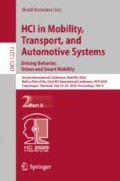Abstract
Uncontrollability of automobiles is one of the factors of traffic congestion on an expressway. The incentive to intrinsic motivation is particularly effective in influencing behavior decisions with continuity and low cost. Gamification is a method of providing motivation that introduces game design elements into non-game contexts. In this study, we proposed a method for inducing a driver on an expressway to take a rest using gamification based on the intrinsic motivation. We created a smartphone application for implementing the proposed method, thereby influencing each driver’s behavior on an expressway in real-time. With our application, a driver takes a break at a rest area to complete quests provided by the application and automatically avoids a traffic congestion. The result of an experiment showed that our method induced significantly long rest compared to a conventional congestion presentation. The results of a user study on a real expressway indicated that the application achieved the rest events with 70% possibility in the best scenario.
Access this chapter
Tax calculation will be finalised at checkout
Purchases are for personal use only
References
The Ministry of Land, Infrastructure, Transport and Tourism (2016). https://www.mlit.go.jp/common/001132350.pdf. Accessed 25 Jan 2020
Okada, N., Nakazato, N., Takeuchi, T., Narumi, T., Tanikawa, T., Hirose, M.: Interactive interface for expressway travel planning with traffic predictions. In: Proceedings of the 2015 ACM International Joint Conference on Pervasive and Ubiquitous Computing and Proceedings of the 2015 ACM International Symposium on Wearable Computers, pp. 13–16 (2015)
Kracheel, M., McCall, R., Koenig, V.: Playing with traffic: an emerging methodology for developing. In: Emerging Perspectives on the Design, Use, and Evaluation of Mobile and Handheld Devices, pp. 105 (2015)
Ryan, R.M., Deci, E.L.: Intrinsic and extrinsic motivations: classic definitions and new directions. Contemp. Educ. Psychol. 25, 54–67 (2000)
Brickman, P., Campbell, D. T.: Hedonic relativism and planning the good society. Adaptation-Level Theory (1971)
Kohn, A.: Punished by Rewards: The Trouble with Gold Stars, Incentive Plans, A’s, Praise, and Other Bribes. Houghton Mifflin Harcourt (1999)
Frey, B.S., Oberholzer-Gee, F.: The cost of price incentives: an empirical analysis of motivation crowding-out. Am. Econ. Rev. 87, 746–755 (1997)
Csikszentmihalyi, M.: Flow: The Psychology of Optimal Experience. Harper Perennial, New York (1991)
Deterding, S., Dixon, D., Khaled, R., Nacke, L.: From game design elements to gamefulness: defining gamification. In: Proceedings of the 15th International Academic MindTrek Conference: Envisioning Future Media Environments, pp. 9–15 (2011)
Uehara, K., Nakamura, F., Okamura, T.: Intention of railway commuters to departure time shifting by incentive measures. Transp. Policy Stud. Rev. 11(4), 2–9 (2009). (in Japanese)
Tokyo Metro Co., Ltd.: Tozai Line off-peak project. https://t.metro-point-club.jp/form/pub/metro/tozailine. Accessed 25 Jan 2020
Pluntke, C., Prabhakar, B.: INSINC: a platform for managing peak demand in public transit. Journeys, Land Transport Authority Academy of Singapore, pp. 31–39 (2013)
McGonigal, J.: Reality is Broken: Why Games Make Us Better and How They Can Change the World. Penguin Publishing Group (2011)
Central Nippon Expressway Company Limited: Congestion forecast calendar. https://dc.c-nexco.co.jp/jam/cal/. Accessed 25 Jan 2020
Swarm—Remember everywhere. https://www.swarmapp.com/. Accessed 29 Jan 2020
PlayStation Official Site. https://www.playstation.com/en-us/. Accessed 29 Jan 2020
Acknowledgements
This research is conducted under a joint research by the University of Tokyo and Central Nippon Expressway Company Limited. We thank the project members and research participants.
Author information
Authors and Affiliations
Corresponding author
Editor information
Editors and Affiliations
Rights and permissions
Copyright information
© 2020 Springer Nature Switzerland AG
About this paper
Cite this paper
Takeuchi, T., Mita, R., Okada, N., Tanikawa, T., Narumi, T., Hirose, M. (2020). Influencing Driver’s Behavior on an Expressway with Intrinsic Motivation. In: Krömker, H. (eds) HCI in Mobility, Transport, and Automotive Systems. Driving Behavior, Urban and Smart Mobility. HCII 2020. Lecture Notes in Computer Science(), vol 12213. Springer, Cham. https://doi.org/10.1007/978-3-030-50537-0_10
Download citation
DOI: https://doi.org/10.1007/978-3-030-50537-0_10
Published:
Publisher Name: Springer, Cham
Print ISBN: 978-3-030-50536-3
Online ISBN: 978-3-030-50537-0
eBook Packages: Computer ScienceComputer Science (R0)

